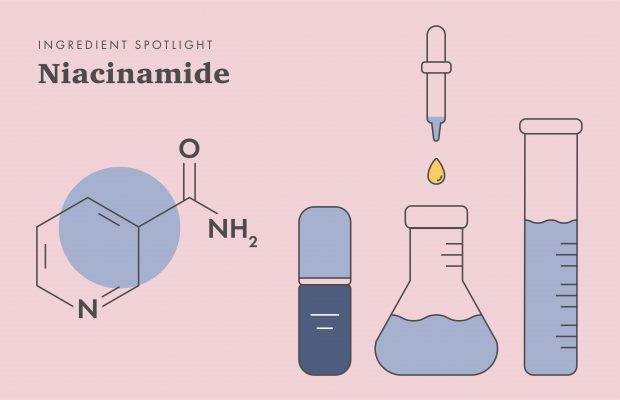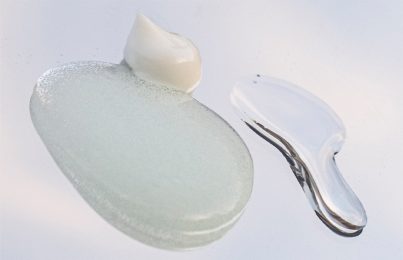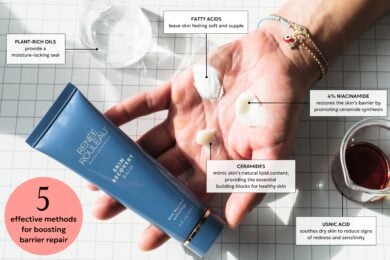Updated 03/10/22. Chances are you’ve heard of niacinamide, but you may not have given it as much thought as you’ve given other popular skincare ingredients. The reason I want to highlight it is that it’s one of the most versatile ingredients out there! It’s a true multitasker, so much so that a lot of people don’t realize just how much it can do! Keep reading to learn everything you need to know about this powerful active ingredient.
What Is Niacinamide?
Let’s start with the basics. Niacinamide, also known as nicotinamide, is a form of niacin (vitamin B3). The body doesn’t produce niacin on its own; instead, it gets it from a well-rounded diet. The role of niacin in the body is to convert food into energy. It also plays a role in cell signaling and DNA repair.
Niacinamide is an effective skincare ingredient, thanks to its ability to successfully penetrate the outermost layer of the skin. It also has a fairly neutral pH, which means it’s unlikely to cause irritation and can remain stable in most formulas.
How Does Niacinamide Benefit the Skin?
Trust me when I say that niacinamide has something to offer you, regardless of your skin type.
Dryness or Dehydration
One of the main skin issues I hear about is dry or tight skin, which can usually be chalked up to a damaged moisture barrier. Your moisture barrier is made up of lipids that help the skin retain moisture while keeping irritants out. When this barrier is damaged, it creates tiny, invisible cracks in the skin. This allows moisture to escape and makes it difficult for your skin to stay properly hydrated. A number of factors can contribute to a damaged moisture barrier, including over-exfoliation, harsh product usage, topical prescriptions, and dry climates.
Now for the good news: niacinamide has been shown to improve barrier function by stimulating the production of ceramides, which is another name for the lipids that make up a healthy barrier. This helps the skin retain water and prevents something called transepidermal water loss, which is the process by which water evaporates from the outermost layer of the skin. In fact, 2% topical Niacinamide has been shown to be more effective than petrolatum for reducing water loss and increasing hydration!
Sensitivity and Redness
Niacinamide supports the skin’s natural defense mechanisms. By strengthening the skin, it makes it less vulnerable to external aggressors, thereby addressing the root cause of sensitivity. It’s even proven to reduce redness and calm rosacea—both of which are often accompanied by heightened skin sensitivity, and it’s all thanks to its impressive anti-inflammatory properties. In fact, niacinamide is so gentle that it’s often used to soothe skin after professional laser treatments and chemical peels.
Oiliness and Blemishes
Niacinamide can even address blemishes—that is, if those blemishes are mild to moderate in severity. If your blemishes are more severe, there are more potent ingredients you can turn to, such as salicylic acid, retinoids, and benzoyl peroxide. However, another advantage of niacinamide is that it’s safe to combine with any of these ingredients for added soothing benefits. In fact, niacinamide has been shown to increase the tolerability of other active ingredients like retinol and retinoids.
Niacinamide addresses breakouts in a few different ways. First, it can decrease inflammation within the skin. This makes it especially appropriate for addressing inflammatory breakouts, like pustules and papules. Second, it provides a slight antimicrobial action that can minimize the amount of breakout-causing bacteria on the skin. Third, it regulates sebum (oil) production, which helps prevent comedones (clogged pores). Studies show that it can effectively reduce the amount of sebum your skin produces in concentrations as little as 2%. Since an excess of sebum is ultimately what causes the clogged pores that lead to blemishes, this is an effective way to minimize breakouts without irritating the skin.
Large Pores
Everyone wants to know how they can minimize the appearance of their pores for a smoother appearance. Well, as it turns out, niacinamide can do that, too. (See? There isn’t much this ingredient can’t do!)
It’s able to do this, in part, because it regulates oil production. Since oil flow expands the pore walls by putting pressure on them, a decrease in oil flow means less stretching of the pore walls. In this way, niacinamide can help pores return to their natural size.
It can also prevent pores from stretching over time by encouraging collagen production. Our natural collagen production starts to drop off after the age of 25, and as this process accelerates, the structure of our pore walls becomes weaker. This leads to more stretching, which is one of the key reasons our pores start to look bigger as we age. Niacinamide stimulates the production of collagen by boosting microcirculation, so it’s a great ingredient to use preventatively.
Pigmentation/Uneven Skin Tone
If you struggle with pigmentation, consider adding niacinamide to your routine. It’s well-established as a brightening agent—even holding its own against hydroquinone, a bleaching agent. Niacinamide can fade dark marks and post-breakout marks, as well as hormonally driven pigmentation, such as melasma.
Pigmentation is your body’s way of protecting the skin after it’s been wounded, usually by some kind of inflammation. Since that wounded skin is vulnerable, your body sends signals to pigment cells, telling them to produce more pigment in order to protect that skin from environmental aggressors like sun damage. (Think of pigmentation as a kind of protective umbrella!). Niacinamide helps lighten pigmentation by inhibiting melanosome transfer from melanocytes to keratinocytes. Translation? It tells your cells that everything is okay, so they stop producing more pigment.
If you’re using this ingredient to address pigmentation, I suggest looking for a product that contains at least 5% niacinamide. It will take about four weeks to see results using a product with this percentage.
Signs of Aging
Niacinamide can improve the appearance of aging skin in a number of ways. Its ability to brighten the skin and minimize the appearance of pores contributes to a younger-looking complexion. And as I said before, it can also boost collagen production.
As we age, our skin can begin to look a bit dull, lacking the natural glow it once had. One way to improve this is by boosting circulation. Niacinamide can stimulate microcirculation in the dermis in concentrations as low as 0.5%. Most ingredients that boost circulation tend to have a high potential for irritation, but niacinamide is unique in that the risk for irritation is very low. Its ability to boost circulation is also how niacinamide stimulates collagen production, which helps plump up fine lines and wrinkles.
Niacinamide can also be combined with other collagen-boosting ingredients, like exfoliating acids, retinol, and vitamin C, making it easier for sensitive skin types to tolerate them.
It even has antioxidant properties that help protect the skin from photoaging (AKA the breakdown of collagen caused by damaging UV rays). If you’re using this ingredient to address signs of aging, I suggest looking for products that contain niacinamide in concentrations closer to 5%.
How Should I Incorporate Niacinamide Into My Routine?
Niacinamide is very stable. It can be used in a variety of formulations thanks to its almost neutral pH. Since it’s water-soluble, the only thing niacinamide requires is a water-based formula (no oil). With that in mind, it’s used in all kinds of skincare products like cleansers, toners, serums, moisturizers, and sunscreens. (I formulated multiple products in my line with niacinamide.)
If you’re looking to target stubborn issues like wrinkles and pigmentation, I suggest looking for a niacinamide serum. Serums have small molecules that can penetrate deep within the skin. Because of this, they can work on a deeper level than something like a moisturizer. My favorite one is the Skin Correcting Serum.
All things considered, niacinamide is definitely an ingredient that should be on your radar. Of course, it’s always important to manage expectations when it comes to skincare. No single ingredient is magic, but niacinamide comes pretty close!
Next, are waterless products better for your skin and the environment?
Celebrity Esthetician & Skincare Expert
As an esthetician trained in cosmetic chemistry, Renée Rouleau has spent 30 years researching skin, educating her audience, and building an award-winning line of products. Her hands-on experience as an esthetician and trusted skin care expert has created a real-world solution — products that are formulated for nine different types of skin so your face will get exactly what it needs to look and feel its best. Trusted by celebrities, editors, bloggers, and skincare obsessives around the globe, her vast real-world knowledge and constant research are why Marie Claire calls her “the most passionate skin practitioner we know.”




Comments:
I’ve wanted niacinamide to work for me but every time I use it, I break out in clusters of tiny pinpoint whiteheads all over my face even where I don’t normally break out. I’m not sure if it’s purging or irritation but normally I don’t purge in this way. Have you come across people who can’t tolerate niacinamide?
Posted By: Tara |
Since niacinamide is a hydrating b vitamin it can’t exfoliate and wouldn’t lead to a purge. You may notice a temporary increase in pustular breakouts if your skin is chronically dehydrated. Rehydrating the skin will help congestion and buildup move out from the pores. Routinely using water-based hydrating products, like Rapid Response Detox Masque will prevent this response!
Posted By: Ella Stevenson |
Hi there Renee..
I would so love to use your range of products.. They sound and look amazing!!!
I say in South Africa..
All the best xxxx
Posted By: Jess |
Thank you!❤️
Posted By: Ella Stevenson |